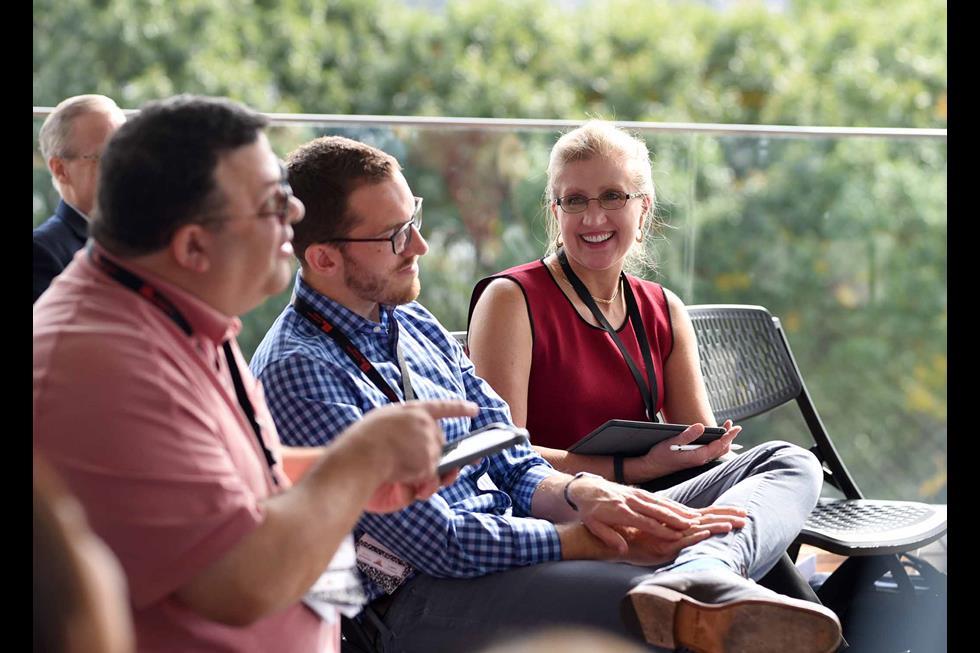Micro Sessions for Innovation
Your Guide to Systemic Innovation Success.
Because companies need help to successfully innovate.
Along the journey, we will stimulate creativity, innovation, and culture change with hands-on sessions.
12 sessions in
1. Define Innovation Success
Assess where are you today and where you want to be in 10 weeks.
2. Leadership Strategy & Alignment
Complete the phrase “We need ideas for…” and make a plan.
3. Team Training
Train your team with the skills they need.
4. Internal Stimulus Mining
5. External Stimulus Mining
Find Customer Insights, Academic Research, Technology, Patents, Data, Trends, Competitors Offerings, Problems, and Unrelated Stimulus
6. Sparking Ideas
Using the diversity of the team to create, build up, and multiply ideas.
12 weeks
7. Communicating Ideas
Rewriting ideas so they are complete concepts that a customer could easily understand and evaluate.
8. Testing Ideas
Test ideas quickly using surveys or experts and learn which have the best odds of success.
9. Problem Solving
10. Risk Assessment
Teams tend to only focus on 1 type of risk at a time, while projects have all types of risks.
11. Forecasting Potential
By modeling uncertainty instead of ignoring it we create an incredibly useful risk-adjusted forecast to aid our judgment and make smarter decisions.
12. Development Decisions
Reports for each idea with the metrics leadership need to make no/go decisions.
What is an innovation?
An idea that is both meaningful and unique.
Meaningful…
To Your Company or Organization
To Your Customer
To You
Unique…
To The World
New & Different
Requires Change
Defining Innovation Success
There is a .26 positive correlation between a proactive culture and new product development success (with proactive cultures creating innovation pipeline’s worth 40% of OVERALL sales vs reactive cultures that create innovation pipelines worth 10% or less of overall sales)
Why?: Before you can chart where you want to go with innovation, it’s important to assess where you are now.
How it works: Through online surveys and interviews, we objectively uncover what your current innovation culture looks like and its impact on your innovation output and pipeline.
Deliverables: In the digital micro-session we’ll reveal the research report results of your innovation
culture, systems, pipeline, and people measured against a benchmark of over 200,000 teams.
This report is then used as stimulus to create a strategic mission.
Leadership Strategy & Alignment
31% of people say there is not a clear link between strategy and innovation projects.
How it works: We facilitate a 2-4 hour strategy meeting with a small team of leaders to define and scope your strategy. It starts with reviewing relevant stimulus we gather before the session (like an innovation assessment report, competitive analysis, benchmarks, etc). Together we’ll work to determine where to focus innovation efforts and build a comprehensive innovation brief outlining the rationale, the objective, boundaries, constraints, opportunity areas, and relevant metrics for success. We’ll also sketch
out a gameplan for what time, energy, budget, and staffing will take to create
and accelerating innovation ideas that fit the strategy.
Deliverables:
Team Training
36% Are fearful about taking action on new innovation. We need to build courage.
Why?: Teams that invest in training employees create higher quality and quantity of ideas to fill their pipeline.
How it works: A cross-functional cohort works together to complete the Innovation Engineering Workshop, a 6-hour virtual training dedicated to teaching people at a high level how to create, communicate and commercialize meaningfully unique ideas. The interactive course is facilitated by an Innovation Engineering Black Belt over Zoom.
Deliverables:
- Staff with the knowledge to participate in innovation efforts
- A framework and common language to encourage innovation collaboration
Internal Stimulus Mining
4. the number of times we’ve been asked to find and negotiate for a key technology that could enable a new innovation only to find that the company already owned the technology
Why?: Finding internal assets to leverage can reduce cost & development time of new ideas.
How it works: Through a series of 30-minute interviews, we’ll work to uncover assets and capabilities that can be exploited for innovation – identifying both hard assets and capabilities but also partnership and “sources of strength” within your organization that you can leverage. The interview list often includes: key leadership, functional area experts, front-line staff, tenured employees and many more, depending on the challenge.
Deliverables:
An Innovation Assets Spark Deck presentation that describes the asset and gives ideas and insights on how they might be leveraged for innovation.
External Stimulus Mining
We need to spark bigger, more radical ideas.
How it works: With a cross functional team* we’ll research external sources for stimulus we can use to inspire fresh thinking. Those sources often include: academic research, customer insights, technology, patents, data, trends, competitive offerings and completely different industries that address the same meta-challenge. We then synthesis all the 100+ insights and discoveries into Spark Decks.
Deliverables: 1 – 3 Spark Decks, nutrient-dense presentations that
share mind-opening insights, ideas & discoveries as well as prompts for how the discovery inspires new solutions for your challenge. The Spark Decks are often incorporated into an idea generation session.
Sparking Ideas
How it works: A cross functional team, working in fast-paced, constantly-changing groups, works together to create ideas for your challenge. Typical sessions last 3 to 6 hours and are facilitated by Innovation Engineering Black Belt experts. Through the session, the teams work through multiple rounds of idea generation. Each one involved 1) getting exposed to stimulus 2) working with a diverse team to invent ideas and 3) capturing ideas in a consistent customer-focused format immediately.
Deliverables:
A collection of customer-focused ideas, typically 25-75 ideas per session. Each idea will include a name, the ideal customer, the customer problem, the promise you can make to address the problem, and the proof that you can deliver.
Communicating Ideas
We need to leverage meaningful marketing strategies.
How it works: We take raw ideas and bring them to completion through a series of 5 communication exercises. Each exercise stretches the idea using stimulus, technology and the team.
Deliverables A collection of ideas communicated to the customers with a clear point of uniqueness, benefit promise and explanation of how it works.
Testing Ideas
72% of executives report that it takes a month or more to create and field research to get customer feedback on a new idea
Why?: A system for quickly testing ideas reduces the need to gamble.
How it works:
Day 1: In a virtual 1-hour meeting we work with you to determine survey design and answer a few key questions.
Day 2: We field the research – using customer surveys or panels of expert raters. By measuring meaningful uniqueness, we can predict an idea’s odds of success.
Day 3: In a virtual 1-hour meeting we meet with you to review results and share our recommendations.
Deliverables: Interactive report with a meaningful uniqueness score and diagnostics to identify weaknesses. The system allows you to “slice and dice” the data to see how the idea performed with different sub-groups, on different attributes, etc.
Problem Solving (cycles of learning)
We see a 28% growth in an idea’s value vs the expected 50% decline when the team has a learning mindset that enables fast cycles to test, change the idea, and retest instead of compromising.
Why? People tend to solve problems using compromise, resulting in worse ideas. Instead, leverage creativity to solve problems and avoid compromising
How it works: Taking your biggest problems we leverage our Plan, Do Study, Act cycles of learning to evaluate how real the problem is and spark ideas to solve it.
Deliverables: Report of what the team learned and new ideas for moving the project forward.
Risk Assessment
Why? Teams tend to only focus on 1 type of risk at a time, while projects have all types of risks.
How it works: In an interactive virtual session with a cross-functional team, we make the risks visible and capture all the possible “death threats” to the project. Then we use the team to help create a plan to mitigate the risk by 1) verifying it 2) design experiments, 3) make connections, and 4) problem-solve.
Deliverables: An outline of the Technology, Organizational, and Market Risks, with a plan for how to address the top risks.
Forecasting Potential
Median actual sales are 26% less than predicted. Forecasts have errors,
but by modeling uncertainty, even wrong forecasts can be useful.
Why? Innovation has uncertainty, so we need to quantify risk.
How it works: Instead of ignoring uncertainty, we model it using risk-adjusted forecasting and Monte-Carlo simulations.
Unlimited access to sales forecasting and estimation tools enables us to try as many scenarios as needed to best predict each project’s potential.
Deliverables: Sales forecast (or another metric) for each idea or scenario that your team needs. Each forecast reports uncertainty using conservative and optimistic outputs and identifies which variables have the most variance.
Development Decisions
We can’t predict the future, but we can bet on projects based on fact rather than feeling.
How it works: Using reports with all the metrics you need to make no/go decision on development makes it very clear what the risks and rewards are for each project. The result is projects being approved based on strategy and logic rather than personnel biases and gut feelings.
Deliverables: Business Opportunity Recommendations for each project.
Typical metrics include sales and cost forecast, market research scores, key dates and timing estimates, next steps, and uncertainties.
Trained Brains
2X or more ideas created by teams with very different thinking styles over those with similar thinking styles.
How it works: In any micro-session you can bring in one or more of our Trained Brains to give you a boost of experience, mental energy, and fresh perspective. They have experience in both the creation and execution of disruptive innovations. They will serve as a member of your team, creating ideas, provoking and challenging rigid thinking. They will also leverage their subject matter expertise where appropriate (new product development, financial, statistics, IP, non-profits, agency, branding, tech, etc.)
Deliverables: On-the-spot contributions to challenge the status quo throughout your session.
CHOOSE THE DESIGN THAT WORKS FOR YOU
Just What you Need, When You Need It
You can do each session discretely as a stand-alone. (Eg. We can test ideas you already have. We can just help you define the strategy. We can give you stimulus to fuel your own brainstorming sessions. We can send Trained Brains to an internal brainstorming session you’re running on your own.)
Go from Desire to Decision in 90 Days
Eureka! plan for success: All 12 sessions in 12 weeks.
If you follow the 12-week Eureka! Plan for Success sequence, you can have a pipeline of ideas that have been vetted, risk-assessed, sized, and tested such that they’re ready to move into development.
Latest Projects
Front End Leadership Workshop
Session 1 & 2 back to back over 2 days to establish a plan and strategy for success.
Pipeline Fill
Sessions 4 through 8 to fill a company’s innovation pipeline with ideas.
Market Research and Sales Forecast
Sessions 8 and 11 to learn more about concepts, pricing and then use that data to create sales forecast for various marketing scenarios.



